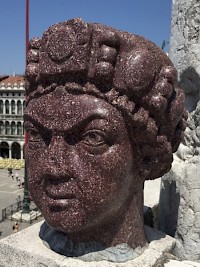Byzantine Capital
Constantinople (Κωνσταντινούπολις) or Byzantium (Βυζάντιον): Greek city on the Bosphorus, capital of the Byzantine Empire, modern İstanbul.

After the brief reign of Justin I, who built the Church of S. Polyeuktos, Justinian became emperor (527). He was to rule the Byzantine Empire for almost forty years, until 565, and the world was to witness not only an impressive expansion of the Byzantine territories, but also the beginning of a period of decline that was to last until the ninth century.
Briefly summarized, his trusted general Belisarius defeated the Sasanian Persians in 530, and a peace treaty was concluded, which enabled the Byzantines to remove troops from the east front and conquer the Vandal kingdom in Africa (534) and Sicily (535). These provinces were among the wealthiest parts of the ancient Mediterranean world, and there were impressive spoils (like the Menorah). Later, Belisarius conducted successful campaigns in Ostrogothic Italy, but was recalled for a brief war against Persia; the subjection of the Ostrogoths finally took place in 552. In the meantime, parts of Andalusia had been conquered.
The city benefited from the proceeds of war; in 542, it may have had about 300,000 inhabitants. A new water reservoir was built: the famous Basilica Cistern or, as it is called today, Yerebatan Sarayı. One of the first building projects conducted was the Church of SS. Sergius and Bacchus, a revolutionary new design: essentially a dome placed on eight arches, in turn supported by eight piers. This design was copied in the Church of San Vitale in Ravenna and inspired the Church of Divine Wisdom (Hagia Sophia), which was to be Justinian's next great project.
The SS. Sergius and Bacchus was still under construction when Constantinople was shocked by serious riots. In January 532, two of the factions in the hippodrome started to fight, and the emperor intervened: the ringleaders were arrested and executed. Next day, the two factions unitedly turned against the emperor. The angry mob stormed the prison, liberated several captured hooligans, and continued to loot the palace and several buildings in the neighborhood. The churches of the Divine Wisdom and Divine Peace were destroyed. In the end, Justinian ordered his mercenaries to attack the looters. About 30,000 Constantinopoliteans were massacred, and that was the bloody end of the Nika riots.

The new Hagia Sophia, based on the design of the Church of SS. Sergius and Bacchus, was begun forty days after it had been destroyed. The architects were Anthemius of Tralles and Isidore of Miletus. Five-and-a-half years later, the church was finished, and Justinian proudly boasted to have surpassed Solomon. It was to be the place of the Second Ecumenical Council of Constantinople in 553, which condemned a text known as "the three chapters", which had once been written to put an end to a schism.
The dome of the new Hagia Sophia collapsed in 558, but was soon restored. Other building projects are the new Church of Divine Peace (or S. Irene), close to the Hagia Sophia, the Hospice of Samson, and the imperial palace. Some of the mosaics of the last-mentioned building can now be seen in the Mosaic Museum. Justinian's courtier Procopius wrote a treatise about all the monuments of his emperor, called Buildings.

In 542, the city suffered from a terrible epidemic. It coincided with the difficult wars against the Ostrogoths and Persians, and the movements of the armies appear to have contributed to the spread of the plague. Constantinople may have lost as many as 100,000 inhabitants, and would never again reach its former size. The loss of lives continued; by the time of the emperor Maurice, in 600, about 100,000 people were living in the city - one third of the population size before the epidemic.

The main victim of the disease, however, was the city-based economy: from now on, the Mediterranean towns were in decline, taxes were hard to gather, trade and crafts suffered, and society lost its coherence. Still, some trade was still possible, and it is interesting to note that in 551 monks from the Far East arrived in Constantinople, bringing silk worms with them. From now on, the production of silk was one of the main crafts in the city.
Still, the city was suffering. Justin II, Tiberius II, Maurice, and Phocas witnessed the slow decline of both the city and the Empire. The energetic Heraclius (610-641) was able to defeat the Sasanians for good, but also witnessed the rapid rise of Islam, which appealed to people who had suffered from the general crisis and the Byzantine-Persian wars. The Arabs were never able to capture Constantinople, but Heraclius' reign marks the end of Antiquity and the beginning of the Middle Ages.